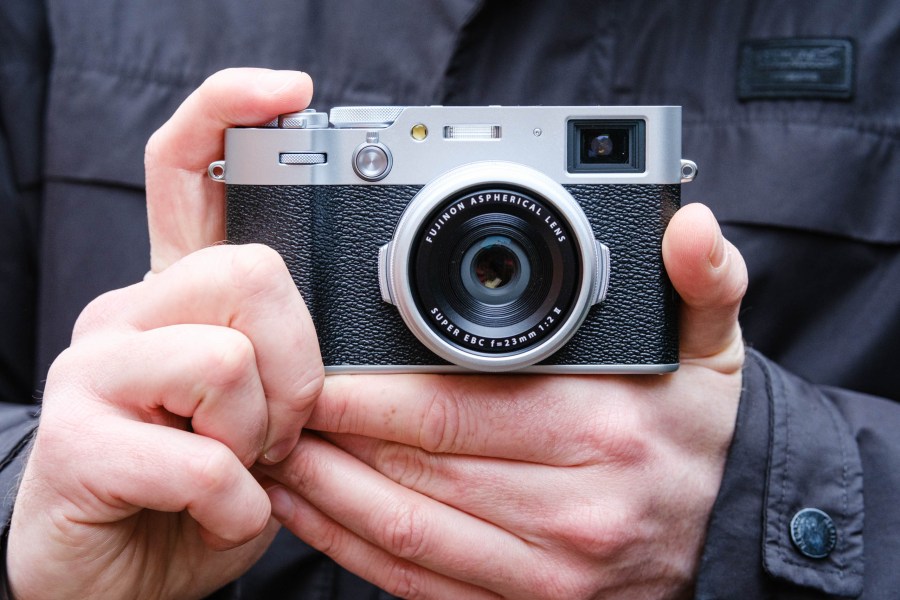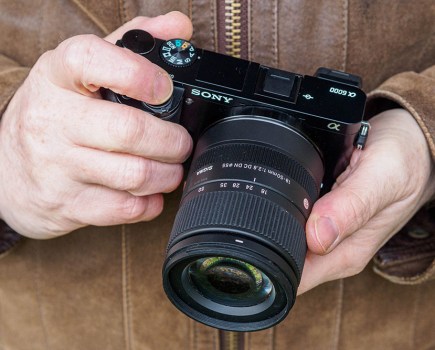Welcome to my roundup of the highlights of the past year, in terms of photographic kit. I’ll take a look back at some of the most exciting and significant cameras and lenses released in 2024. But first, let’s examine some key trends.
Perhaps the most significant milestone of 2024 is that, at the time of writing, it looks set to be the first year since the late 1990s that not a single new DSLR model has appeared at all. Nor have there been any new lenses for DSLRs. It’s been four years since either Canon or Nikon introduced an EF or F-mount product, and while Ricoh has gamely attempted to keep the Pentax K-mount alive, it now appears to have turned its attentions elsewhere. It’s clear that the shift to mirrorless is (almost) complete.
But while DSLRs are in decline, we’ve seen an unexpected and delightful resurrection of 35mm film compact cameras. The Pentax 17, Alfie Tych+, and Rollei 35AF have all appeared offering their own distinct charms. Prices are high at the moment, reflecting low production runs and the cost of developing new models, but fingers crossed they might come down. It’s too early to tell whether this could be the start of a sustainable trend, but we’d love to see more such cameras appear. Indeed, the half-frame Pentax 17’s body appears to have been designed to accommodate full-frame in future, so maybe a ‘Pentax 36’ will appear in due course.
Elsewhere the market seems to have settled into a mix of mostly high-end mirrorless models and premium compacts. Indeed, the big story at the start of the year was the Fujifilm X100VI – a lovely retro-styled compact that was supposedly the most pre-ordered camera ever. Despite Fujifilm doubling its production capacity compared to the previous model, it’s still impossible to find in stock.
There have been some seriously impressive high-end full-frame cameras, too, including the Canon EOS R1 and R5 Mark II, Leica SL3, Nikon Z6III, and Sony Alpha A1 II. Micro Four Thirds fans were well-served by two impressive flagships, the OM System OM-1 Mark II and Panasonic Lumix GH7; with any luck there’ll be some more affordable options next year. Thankfully we have seen some reasonably wallet-friendly APS-format cameras, with the charming little Fujifilm X-M5 and the capable-looking Nikon Z50II.
When it comes to lenses, the initial rush from Canon and Nikon to fill out their full-frame mirrorless line-ups has calmed down, and they’ve now entered a phase of filling out the gaps. Canon has also finally taken the first tentative steps to opening the RF mount to third-party makers. 2024 also saw an array of Chinese firms, including Viltrox, 7artisans and Sirui, making a concerted attempt to break open the third-party lens market with some strikingly affordable optics. This can only be a good thing for cash-strapped photographers.
Quick list
Here’s a list of our picks of the best mirrorless and compact cameras and lenses in 2024, with quick links to the best prices:
Looking for the best deal? Not only will you find the best cameras and lenses, but you’ll also find some of the best camera and lens deals, as our ‘Buy now’ buttons are setup to automatically take you to the best prices, from trusted retailers, plus you’ll also find a list of other retailers below each camera and lens, so you can find the right deal for you.
Best mirrorless cameras in 2024
- Canon EOS R5 Mark II – Buy now
- Fujifilm X-T50 – Buy now
- Nikon Z6III – Buy now
- OM System OM-1 Mark II – Buy now
- Panasonic Lumix GH7 – Buy now
- Sony A1 II – Buy now
Best compact cameras in 2024
Best lenses in 2024
- Nikon Z 28-400mm F4-8 VR – Buy now
- Panasonic Lumix S 100mm F2.8 Macro – Buy now
- Sigma 28-45mm F1.8 DG DN Art – Buy now
- Tamron 50-300mm F/4.5-6.3 Di III VC VXD – Buy now
Why you can trust Amateur Photographer
We spend many hours testing every product we recommend, in detail, in a variety of situations and shooting scenarios, and only use experts for our reviews, so you can be sure that you’re getting the best products. Find out more about our expert writers.
Let’s take a closer look at some of the most interesting and impressive cameras and lenses of 2024…
Canon EOS R5 Mark II
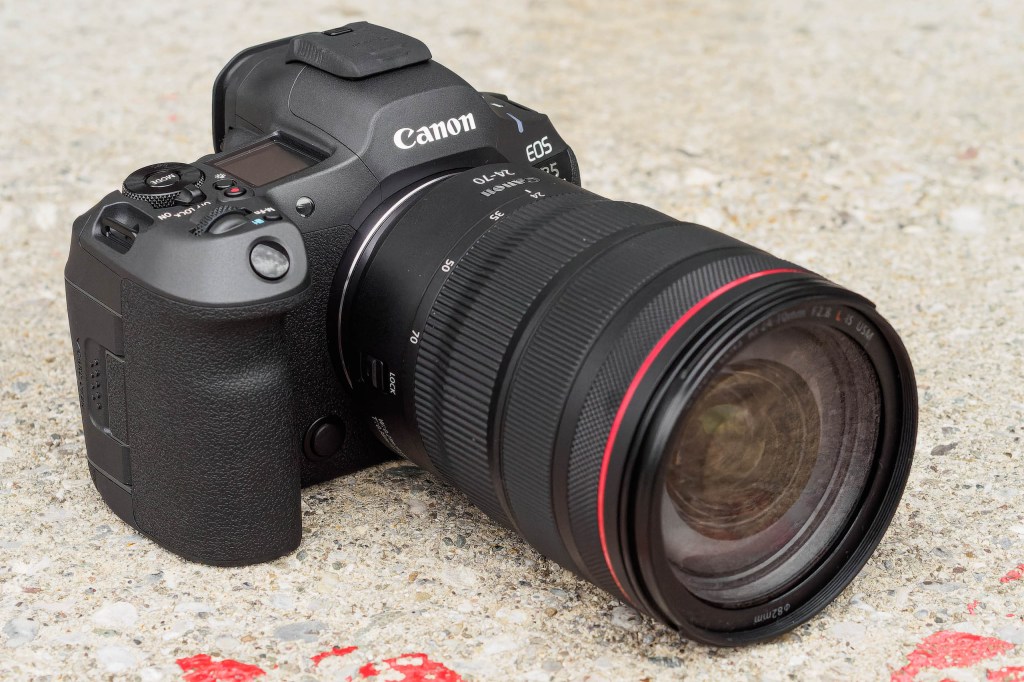
- £4500 body-only
- canon.co.uk
Why we like it:
- Excellent handling
- Impressive performance
- Eye control focus
Canon’s successor to its four-year-old EOS R5 may, at first glance, appear to have much the same design and specification. But in fact, it comes with a huge array of updates and improvements. Launched alongside the sports-focused Canon EOS R1, it’s designed to be a pro-spec all-rounder that can handle almost any task for either photography or video. To this end, the EOS R5 Mark II sports a new 45MP back-illuminated sensor, can shoot at up to 30fps, and record 8K video at 60fps.
The camera gets a serious boost in power, too, thanks to a new DIGIC Accelerator processor that works in concert with a conventional DIGIC X processor. This enables new autofocus features, faster video shooting, and generally more responsive operation. For sports photographers, a clever Action Priority mode uses ball tracking to shift focus onto the active player. The camera also gains Canon’s unique Eye Control Focus technology, that allows you to select your subject simply by looking at it the viewfinder. Videographers should appreciate the new heat management system that enables longer recording times – including an optional add-on cooling fan.
In terms of design and handling, though, the camera maintains almost the same design as before, with only minor tweaks. This will make it easy for existing users to pick it up and get going straight away. One welcome change they will immediately notice, though, is a significantly brighter viewfinder.
In essence, the EOS R5 Mark II fixes all the flaws of its predecessor, while adding some unique and useful new features. It counts as a compelling update over the original R5, and a huge upgrade for anyone still using an EOS 5D-series DSLR. It’s without doubt one of the most capable and versatile cameras you can buy.
Read our full review of the Canon EOS R5 Mark II.
Fujifilm X-T50
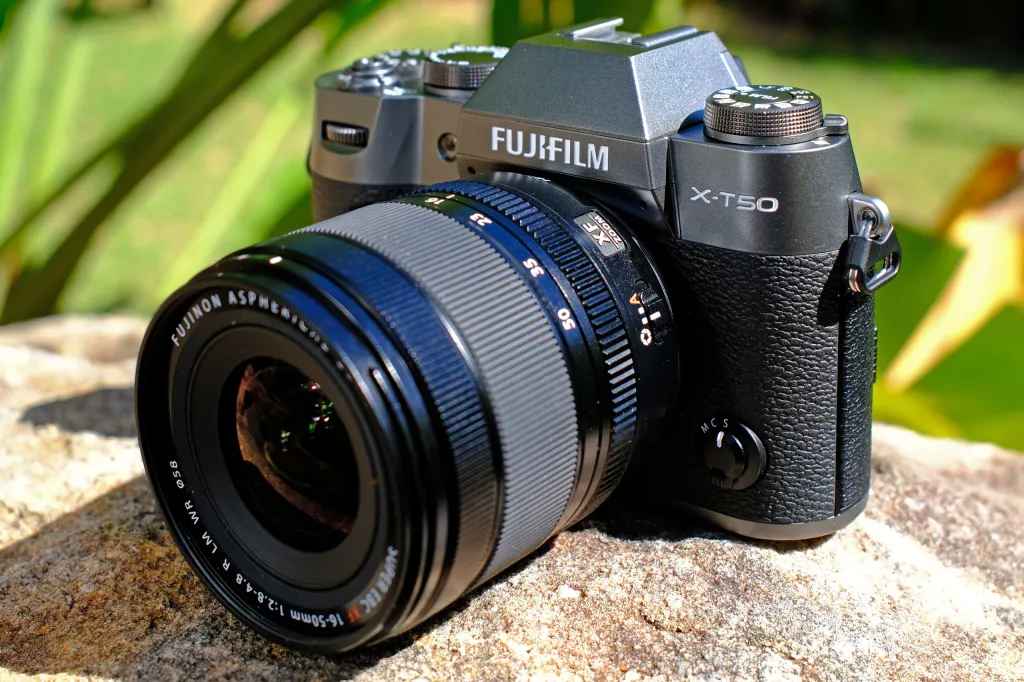
- £1299 body-only
- fujifilm.com/uk
Why we like it:
- Impressive image quality
- In-body image stabilisation
- Film Simulation dial
We’ve long appreciated Fujifilm’s ‘double-digit’ X-T series cameras for their winning blend of compact size, engaging handling and excellent image quality. The X-T50 follows on in same vein, while gaining all the same updates as the X100VI. These include a 40MP sensor, 6K video recording, in-body image stabilisation, and subject detection autofocus. Together, they place it right at the top of its class in terms of spec.
One of the X-T50’s most interesting – and controversial – new features is, however, a control. Where the dial on the top left previously controlled drive modes, it’s now used to select between the most popular Film Simulations. This embodies a clear trend this year of offering users more direct control over the look of their video and stills output. Both Nikon and Panasonic have done something similar, if via buttons, on the Z50II and S9 respectively.
I can see why some people really don’t like this, but personally I think it’s a great idea. The beauty of Fujifilm’s Film Simulations is that there are lots of great options which are suitable for different subjects and shooting situations. So there’s a lot to be said for providing a control that makes them much more accessible. Obviously it’s most useful to JPEG shooters, but even if you intend on shooting raw, it allows you to preview different looks while shooting.
Regardless of whether or not you take to that dial, the X-T50 is a fabulous little camera. You get pleasing colour reproduction, effective image stabilisation, and stacks of detail courtesy of that 40MP sensor. The camera handles really nicely and Fujifilm offers the best range of APS-C lenses available. Ultimately, you won’t find a better APS-C camera at this price.
Read our full review of the Fujifilm X-T50.
Nikon Z6III

- £2700 body-only
- nikon.co.uk
Why we like it:
- Stunning viewfinder
- Innovative sensor tech
- Superb AF system
When Nikon first showed us the Z6III, the message was that this enthusiast-focused camera was aiming to deliver many of the capabilities of the pro-spec Nikon Z8 in a smaller and more affordable package. Key to this is its innovative ‘partially stacked’ CMOS sensor. By bonding additional processing circuitry onto the image sensor, it should bring many of the advantages we’ve previously seen from fully stacked sensors, but at a lower cost. On the Z6III this turns out to work extremely well, and there’s a strong chance it could become the dominant sensor technology in future.
The key advantage this brings to the camera’s 24MP full-frame sensor is rapid readout speed, which translates to dramatically improved autofocus compared to the previous Z6II. You get a highly reliable subject detection system that understands people, animals, vehicles, and planes, with the ability to select automatically between different subject types. You also get a dramatic update to video recording, as the Z6III boasts internal 12-bit RAW video recording at 60fps, in either 6K or 4K resolution from the full sensor width
Another major update comes with the viewfinder. It’s not just higher in resolution than before, it’s also extremely bright, at 4000 nits. The colour gamut is unusually large too, encompassing the DCI-P3 colour space. This results in one of the best viewing experiences of any mirrorless camera. The screen is fully articulated too, rather than just tilting up and down. In design terms, things otherwise stay much the same as before. The camera feels great in your hand and all the controls are well placed.
In summary, the Z6III is an extremely accomplished all-rounder that’s capable of tackling almost anything you might ask of it. Regardless of what you’re shooting – sports, portraits, wildlife, or landscapes – it’ll deliver great results. It’s at least a match for any other camera in its class, and a great choice for serious enthusiast photographers.
Read our full review of the Nikon Z6III
OM System OM-1 Mark II

- £2150 body-only
- explore.omsystem.com
Why we like it:
- IP53 weather sealing
- Clever computational features
- Clever Live Grad ND
While OM System – formerly Olympus – has had something of a quiet year, it did come out with an update to its flagship OM-1 model at the start of 2024. The firm seems to have pinned its colours to the mast of outdoor and wildlife photography, so what you get is a small yet rugged camera that’s backed up a good range of matched high-quality lenses. It also stands out thanks to a wide array of interesting and useful computational photography features.
Compared to its predecessor, the Mark II provides improved continuous autofocus and subject recognition performance. It also has double the buffer for extended burst shooting up to 256 shots in raw. But perhaps the standout addition is a clever new in-camera live graduated ND filter that, as its name suggests, can selectively darken specific areas of your image, set via an intuitive onscreen interface. You can select the density and softness, move the position and change the angle, all previewed in real time.
Otherwise, it’s the same winning recipe as the original OM-1, and indeed the Olympus E-M1 series before it. You get a large comfortable handgrip, with excellent build quality including high levels of weather sealing to the IP53 standard. The superb 5.76m-dot viewfinder is backed up by a fully articulated touchscreen. Continuous shooting is ludicrously quick – 50 frames per second with continuous autofocus, or 120fs with fixed focus – and the in-body image stabilisation is particularly impressive.
Ultimately, the OM-1 Mark II is a fast and robust camera, that lets you build a setup with smaller, lighter, and often less-expensive lenses than its full-frame or even APS-C rivals.
Read our full review of the OM System OM-1 Mark II.
Panasonic Lumix GH7

- £2000 body-only
- panasonic.com/uk
Why we like it:
- Excellent autofocus
- Great handling
- Huge array of video features
Panasonic’s GH-series cameras have always been highly prized by hybrid shooters looking to shoot high-end video as well as stills. With the GH7, the firm has updated the four-year-old GH6 with massively improved autofocus, thanks to the addition of both phase detection and subject recognition. The camera also gains a new backside-illuminated sensor, ProRes video support, and enhanced audio recording via the optional DMW-XLR2 mic adapter.
While the GH line is generally considered to be all about video, that ‘H’ stands for Hybrid and the camera has impressive photography features too. For example, you get super-fast shooting at up to 75fps with focus fixed, and 60 frames per second with continuous autofocus. The 25MP sensor should be up to most tasks but if you need more resolution, there are both tripod-based and hand-held high-resolution multi-shot modes that are genuinely practical in a way that most other brands aren’t, and giving 50MP or 100MP output.
Where the GH7 really stands out, though, lies with its video capabilities. It offers a vast range of options in terms of resolution, framerate, aspect ratio, colour depth, encoding schemes and file formats. You can shoot anything from ‘open gate’ 5.8K at 30fps, though 17:9 5.7K at 60fps and C4K at 120fps, to 16:9 Full HD at 240fps. A built-in fan promises practically unlimited recording time and there are some handy additional video-specific controls, too.
All this comes with the usual very real attractions of the Micro Four Thirds system, with relatively small, lightweight and affordable lenses, and the ability to achieve huge telephoto reach. And yet most of the time, it’ll give results every bit as good as those from a full-frame system. For those shooting both high-end video and stills, the GH7 is a really compelling proposition.
Read our full review of the Panasonic Lumix GH7
Sony Alpha 1 II

- £6300 body-only
- sony.co.uk
Why we like it:
- Super-high specification
- Refined design and operation
- Excellent viewfinder and screen
Sony has had a relatively quiet year in terms of new camera releases, but it made up for this in November by launching its new top-of-the line flagship, the Alpha 1 II. In essence, this takes the same headline capabilities as the original A1 – 50MP shooting at 30 frames per second, coupled with 8K 30p video recording – but places them into an updated body design borrowed from the Alpha 9 III. Plus, of course, you get all the firm’s latest technologies and feature updates. The result is a camera that, on paper at least, out-specs any of its rivals.
For autofocus, you get the latest version of Sony’s superb subject detection and tracking system. At long last, the firm has included the option to have the camera work out automatically what type of subject it’s shooting, rather than forcing you to set it in advance. There’s also a new option for configuring custom AF areas of exactly the size and shape you need.
That’s not all. For sports and action shooting, the A1 II borrows the Pre-Capture and Continuous Shooting Speed Boost options first seen in the A9 III. Improved in-body image stabilisation is now rated to deliver up to 8.5 stops of shake suppression. You get the biggest, highest-resolution viewfinder in a full-frame camera and the most flexible screen articulation. Sony also says it’s improved the auto white balance, exposure, colour reproduction, and high-ISO processing, compared to the original A1.
This all adds up to a camera that should be able to handle anything you might possibly throw at it. If there’s a catch, it’s that the A1 II is considerably more expensive than either of its most obvious peers, the Nikon Z8 and Canon EOS R5 Mark II. But it might turn out to be the most capable all-rounder of them all.
Read our full review of the Sony Alpha 1 II.
Fujifilm X100VI
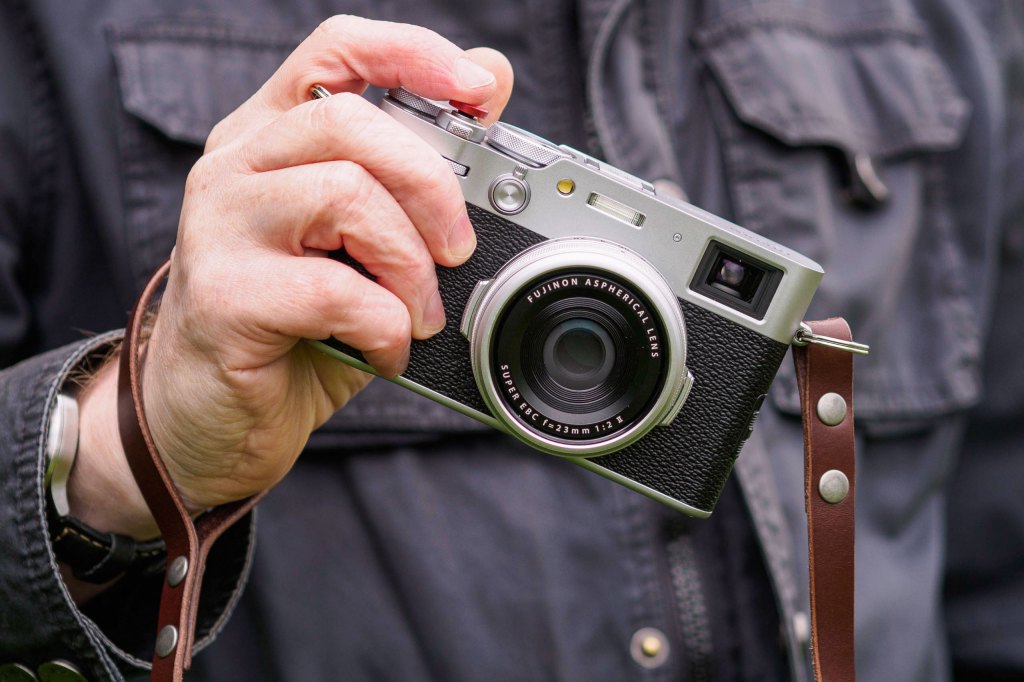
- £1600
- fujifilm.com/uk
Why we like it:
- Stunning retro design
- Fabulous image quality
- In-body image stabilisation
When Fujifilm updated its cult-classic X100V at the start of the year, it can have had little idea of how things were going to play out. The X100VI maintained all the best bits of its predecessor, including a fixed 35mm equivalent lens, traditional analogue controls, and a unique hybrid optical-electronic viewfinder, all in a classic retro-inspired design. But it added a bunch of desirable new features, including a 40MP sensor, in-body image stabilisation, and subject-detection autofocus.
With a feature set like this, the X100VI was always going to be popular, but nobody could have predicted just how much. The instant the camera was announced, the pre-orders flooded in. Almost a year after its launch you still won’t find one in stock, but instead have to place your order and wait patiently for it to arrive.
It’s easy to dismiss the X100VI as some sort of hipster craze; after all, the X100V had been much-hyped by TikTokers and impossible to buy for months. But the thing is, there’s plenty of substance behind that mesmerising style. This is a camera that’s lovely to shoot with and capable of delivering stunning results. Thanks to Fujifilm’s peerless Film Simulations, it gives great JPEG output, while that 40MP sensor provides plenty of scope for cropping into your images to fine-tune the composition.
Of course, it’s not perfect. Not everyone will be able to live with a fixed lens, and its autofocus is relatively sluggish. Some will balk at the storage and processing demands of those 40MP files, too.
Ultimately, though, the X100VI is a gorgeous and highly desirable camera. There’s very little to dislike here, and a lot to love. If you’ve been turned cold by cameras that have no soul, this one is for you.
Read our full review of the Fujifilm X100VI.
Leica Q3 43
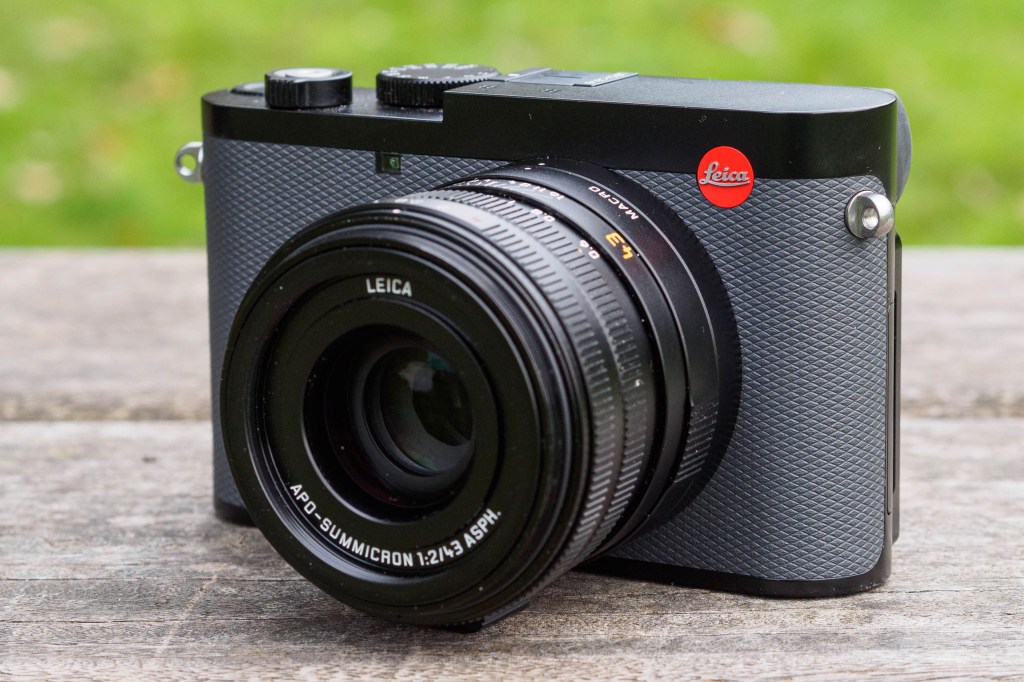
- £5,900
- leica-camera.com
Why we like it:
- Superlative ‘perfect normal’ lens
- Incredibly robust build
- Fantastic image quality
We’ve long been fans of Leica’s Q-series cameras, which have combined a full-frame sensor and fixed 28mm f/1.7 lens in a body that resembles the firm’s iconic M-series rangefinders. But this year, we got a variant with a brand-new 43mm f/2 lens. It’s probably the best compact digital camera ever made.
But why a 43mm lens, rather than 35mm or 50mm? The rationale lies in what defines a ‘normal’ lens; i.e. one that delivers the most natural perspective to images. Let’s say we were to take a photo, make a print, and then view it at a comfortable distance, from precisely the same location where it was shot. Which focal length would give an image that exactly overlays the real scene? If we accept that a ‘comfortable viewing distance’ is equal to the print diagonal, then it turns out that a ‘perfect normal’ lens has a focal length equal to the diagonal of the sensor. On full-frame, that’s 43.3mm.
This is a roundabout way of saying that the Leica Q3 43’s lens gives images that somehow just look ‘right’, as if we’re standing within the scene itself. Equally importantly, it’s a superlative optic that’s every bit as sharp wide open as it is at f/11. Coupled with the excellent 60MP sensor, it gives consistently wonderful photos. If that’s not enough to fall in love with a camera, I’m not sure what is.
Yet there’s more. The Q3 43 is superbly built, with full weather sealing, an excellent viewfinder, and a tilting screen. You get a traditional shutter speed dial, aperture ring, and manual focus ring. The design is wonderfully stripped-back, removing distractions and leaving you free to concentrate on shooting.
This is a Leica, though, so it’s fabulously expensive. But for those that can afford it, this is as good as cameras get.
Read our review of the Leica Q3 43.
Rollei 35AF
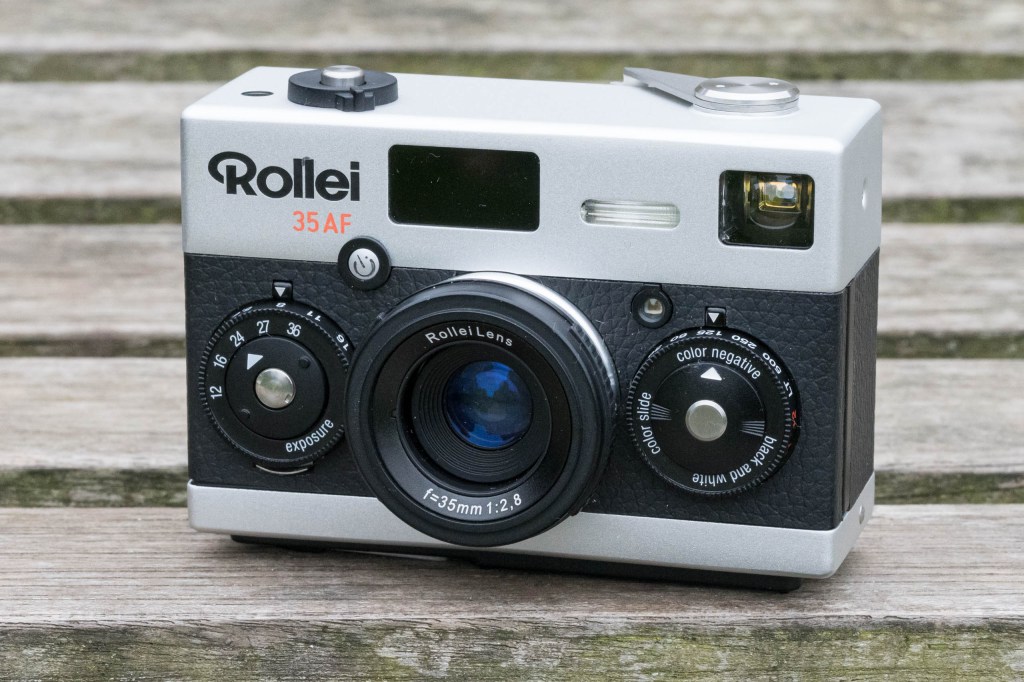
- £775
- rollei35af.com
Why we like it:
- Compact size
- Classic styling
- Auto or manual exposure
For those who grew up with – or simply appreciate – mechanical film cameras from the 1960s and 1970s, the original Rollei 35 counts as an outright classic. At one point the smallest full-frame 35mm camera around, it employed a quirky design that some photographers adore, but others find infuriating. Now Mint Camera has produced an all-new design that borrows many of the same features, but with one major update – autofocus.
We haven’t reviewed the Rollei 35AF properly yet, but I’ve been playing with one for a while. Building an entirely new camera to resemble the original was always going to involve treading a fine line between paying tribute and creating a pastiche, and in many respects, I think Mint has got things right. The camera looks fabulous and faithfully recreates much of the unique user experience, including shutter speed and aperture dials on the front, and the left-hand film wind. But now, rather than having to guess your focus distance, the camera will set it for you. You get a choice between aperture-priority and manual exposure, too.
Where the 35AF doesn’t quite live up to its illustrious predecessors, though, lies with the smoothness and sophistication of operation. Its viewfinder is small and distorted, and the film transport feels distinctly rough. The body is both slightly bulkier – including a fixed, rather than retractable lens – and noticeably lighter, which makes it feel cheaper. So if you’ve used a classic Rollei 35 before, you might find these aspects slightly disappointing.
Despite this, the 35AF is a lot of fun to shoot with and crucially, it gives very creditable results. You’ll struggle to match this feature set when buying a 35mm film camera second-hand. But the real stumbling block is availability; it’s expensive and hard to find. You may just be better off getting a classic Rollei 35 instead.
Read more about the Rollei 35AF.
Nikon Nikkor Z 28-400mm f/4-8 VR
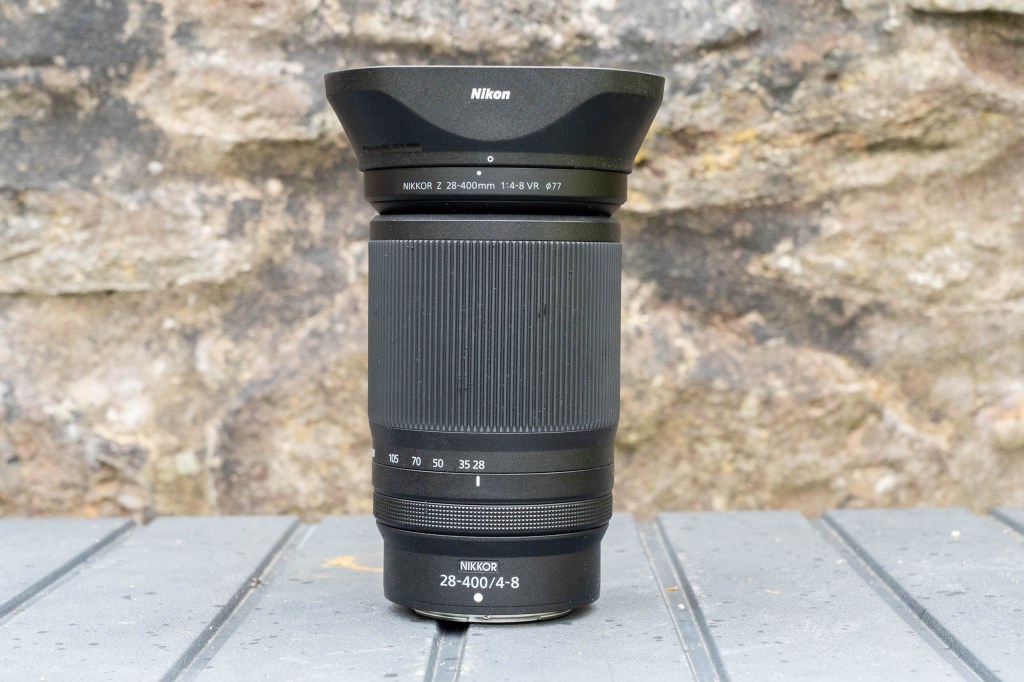
- £1400
- nikon.co.uk
Why we like it:
- Huge zoom range
- Light weight for a 400mm lens
- Decent value
One under-appreciated benefit of the shift to mirrorless is how it’s allowed lens makers to produce designs that just wouldn’t work with DSLRs. Freed from same constraints around optical distortion correction, viewfinder brightness, and backfocus distance, they’ve been able to deliver lenses that previously weren’t possible. This is a classic example, and the longest-range superzoom lens yet made for full-frame cameras.
That huge 28-400mm zoom range, coupled with a short minimum focus distance, results in unprecedented versatility. Potentially it can cover subjects as diverse as landscapes, portraits, close-ups, sports and wildlife, making it a great choice for situations such as travel or day trips when you’re trying to keep your bag as light as possible.
It’s not a huge lens either, at 141.5mm in length and 725g, which makes it practical for day trips and comfortable for hand-held shooting. It also takes perfectly manageable 77mm filters. You get quick, silent autofocus and effective optical stabilisation. The images it produces are very good, and with its sheer reach it opens up subjects that might not have otherwise been within the average photographer’s budget. In summary, it’s a great all-rounder.
Read our full review of the Nikon Nikkor Z 28-400mm f/4-8 VR
Panasonic Lumix S 100mm F2.8 Macro

- £1000
- panasonic.com/uk
Why we like it:
- Remarkably small and light
- Life-size magnification
- High-quality optics
This striking lens appeared right at the start of 2024. It’s a 100mm macro lens for full-frame L-mount cameras, that delivers life-size magnification. That may not sound remotely remarkable, except somehow it manages to do so in a design that’s just 8.2cm long and weighs less than 300g. In context, its closest competitor, the Sigma 105mm F2.8 DG DN Macro, measures 13.4cm and 715g, which is pretty typical for its class. This Lumix lens is just so much easier to carry.
Technically, Panasonic achieved this tiny size by using a ‘dual phase linear motor’ that moves two focus groups internally in opposite directions. About the only practical compromise is a relatively short working distance of 10cm between the front of the lens and the subject. Otherwise, you get much the feature set we’d expect, including dust-and splash-resistant construction and a focus limiter switch to reduce hunting.
Optical quality reaches the high standards we’d expect for a macro lens, with impressive levels of detail wide open. You get attractively blurred backgrounds, too, not only for close-ups but also for portraits. Overall, this is a fantastic lens that redefines what a 100mm macro can look like.
Read our full review of the Panasonic Lumix S 100mm F2.8 Macro
Sigma 28-45mm F1.8 DG DN Art
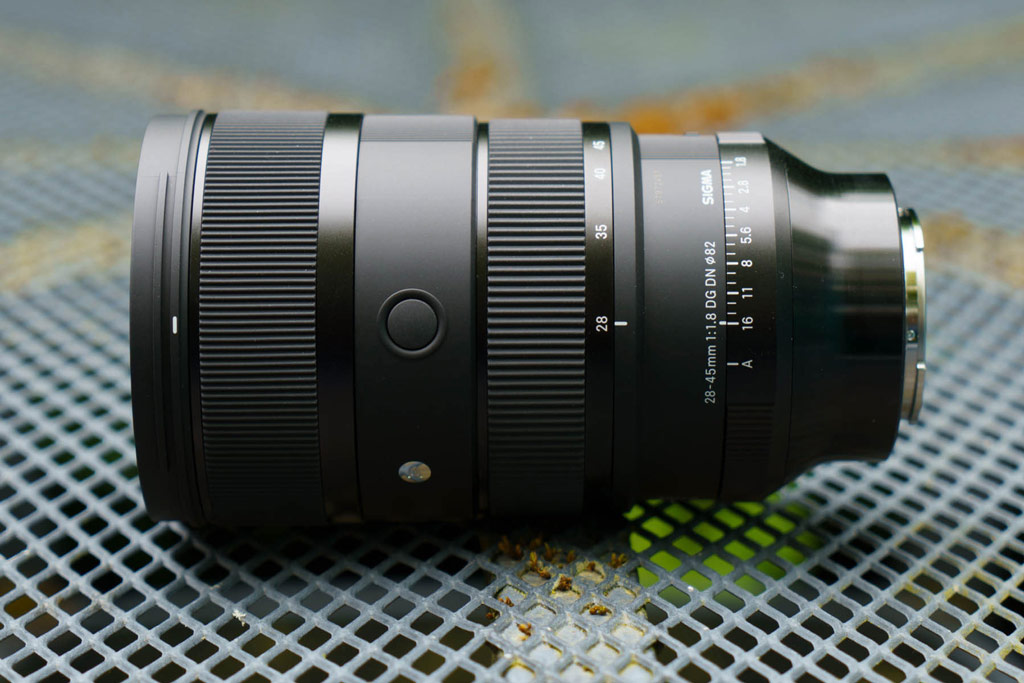
- £1300
- sigmauk.com
Why we like it:
- Super-bright f/1.8 aperture
- High image quality
- Weather-sealed design
Sigma has broken new ground for full-frame zoom lenses, with the world’s first to feature a constant maximum aperture of f/1.8. This means it gathers 1.3 stops more light than a conventional f/2.8 zoom, making it useful in low-light conditions or when you want to separate a subject from its background. It’s available for L-mount and Sony E-mount.
Inevitably, creating an f/1.8 zoom involves compromises to make it manageable. The most obvious is the limited zoom range, but even so it can effectively replace three primes: 28mm, 35mm, and 45mm. Another penalty lies in the size and weight, although it’s perhaps not as large as you might think, measuring 153mm long and 950g.
What you do get, though, is everything that has made Sigma’s Art series a byword for quality. Optically, it delivers exceptional performance across its focal-length range and at all aperture settings. Autofocus is fast, quiet and accurate, while breathing is well controlled. You get weather sealing and a full set of controls, including an aperture ring. A lens like this isn’t going to be for everyone, but it’s great that Sigma has given photographers the choice.
Read our full review of the Sigma 28-45mm F1.8 DG DN Art.
Tamron 50-300mm F/4.5-6.3 Di III VC VXD

- £820
- tamron.eu
Why we like it:
- Really useful zoom range
- Relatively small and light weight
- Impressive close-up ability
Tamron is another lens maker that likes to think outside the box, although in a subtly different way. Over the past few years, it’s come up with an array of lenses with unusual focal-length ranges that don’t simply replicate those that became the norm for DSLRs. Its 50-300mm F/4.5-6.3 is a telephoto zoom that extends its wider end into what we’d consider ‘standard’ lens territory. It’s available for full-frame Sony E-mount cameras only.
While this may look like a subtle change, it turns out to have a real practical impact. It means you can keep the lens on the camera more of the time and waste less time changing lenses. It also means you can put together a much smaller and lighter kit. In fact, some photographers might be entirely happy pairing this lens with a short standard zoom such as the Sony 24-50mm f/2.8, or Tamron’s own 20-40mm f/2.8 and 17-50mm f/4.
Crucially the lens is a great performer too, delivering excellent image quality backed up by fast, silent and accurate autofocus. You also get effective optical stabilisation and moisture-resistant construction. It’s a fantastic telephoto zoom for Sony users looking to travel light.
Read our full review of the Tamron 50-300mm F/4.5-6.3 Di III VC VXD.
Related reading:

